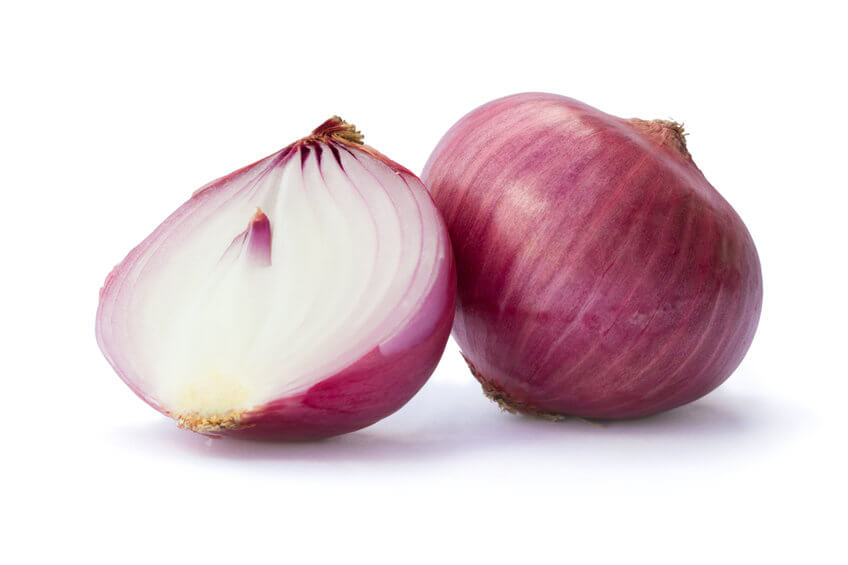Onions come in many shapes, sizes, and colors. They also have many different uses. If you’ve ever found yourself wondering what the difference is between different types of onions — whether it be their nutritional content or taste — then today you’re in luck. In this article we’ll be ironing out all of the differences between red onion vs yellow onion.
In short, the nutritional difference between red onion vs yellow onion is negligible. What differentiates them is their taste, with red onion having a milder flavor that makes it subtle for eating raw. Yellow onions, however, are preferable when cooking due to their strong flavor and caramelizing effect when heated.
Let’s examine these details further.
Red Onion VS Yellow Onion
The most obvious difference between red onions and yellow onions is their appearance.
Red onions are, as their name suggests, red. They have a deep purple skin with red flesh and a white core and are sometimes referred to as “purple” onions.

Red onions are bulbous and medium-large in size.
Yellow onions, on the other hand, are yellow or brownish-yellow in color. They have a thin layer of skin that covers light yellow flesh with a white (or sometimes greenish-tinged) core.

Much like red onions, yellow onions are also bulbous and medium-large in size.
Culinary Use
Possibly the biggest difference between red onion vs yellow onion is how they’re used.
Red onions are preferable when eaten raw (or used as a raw ingredient) due to their milder flavor than yellow onions.
Some of the ways in which red onions can be used include:
- As a salad topping
- As a topping for burgers and sandwiches
- In salsa, diced
Yellow onions, on the other hand, have a much more intense flavor and odor, making them less desirable if eating raw. Instead, yellow onions are best when cooked.
Cooking yellow onions makes their flavor mild and savory. It also produces a caramelizing effect.
Some of the ways in which yellow onions can be used include:
- In soups and stews
- Fried in hash browns
- Made into onion rings
These are just a few examples. Both red and yellow onions can be used in countless ways.
Difference In Taste & Texture
Although they come from the same genus and species, there is a noticeable difference in taste between red onion vs yellow onion.
Red onions tend to be milder and sweeter than yellow onions. This is likely due to the sulfur and sugar content. Cooking red onions will make their flavor even milder, although there isn’t much of a caramelization effect when compared to yellow onions.
Yellow onions, on the other hand, have a sharper flavor that’s perfect for cooking. When heated, they take on a milder sweetness with a savory edge. Yellow onions also caramelize very well, making them ideal for dishes that require roasted or fried onions.
The texture of red onions is slightly different from yellow onions as well. Red onions are crisp and crunchy, while yellow onions are more chewy.
Seasonality & Availability
Both red and yellow onions are available year-round.
Mostly grown in the spring through fall months, onions grow best in mild climates with direct sunlight and well-drained soil.
Nutrition Facts
Now that we’ve gone over some of the main differences between red and yellow onions, let’s have a look at how they compare nutrition.
The table below compares the nutrition facts of a 100-gram serving of raw red onions with an equal serving size of raw yellow onions:
| Item | Red Onion | Yellow Onion |
| Serving Size | 100 grams | 100 grams |
| Calories | 44 | 38 |
| Total Carbohydrates | 9.9g | 8.6g |
| Fiber | 2.2g | 1.9g |
| Total Fat | 0.1g | 0.1g |
| Protein | 0.9g | 0.8g |
| Calcium | 1% DV | 1% DV |
| Iron | 1% DV | 2% DV |
| Potassium | 4% DV | 4% DV |
| Vitamin C | 9% DV | 9% DV |
| Magnesium | 3% DV | 2% DV |
| Zinc | 2% DV | 2% DV |
As you can see, the nutritional difference between red onion vs yellow onion is negligible at best. Both varieties of onion contain:
- Dietary fiber: an indigestible carbohydrate that helps remove waste from the body
- Protein: a macronutrient made up of amino acids, tasked with building and repairing muscle tissue
- Vitamin C: a water-soluble vitamin that also acts as an antioxidant
- Electrolytes such as potassium and magnesium
Health Benefits
Finally, both red and yellow onions come packed with numerous health benefits.
According to WebMD, onions contain an antioxidant known as quercetin, which may help fight inflammation and boost immune health.
Some additional health benefits of onions include…
- Having an anti-inflammatory effect [Source]
- May reduce cancer risk [Source]
- Promote heart health [Source]
…And many more. These are just a handful of examples.
The Bottom Line
In conclusion, red onion vs yellow onion is a matter of taste and preference. Both varieties are rich in nutrition and health benefits, and they’re also abundant and cheap enough to be accessible to nearly everyone. So, why choose one when you can try both?

